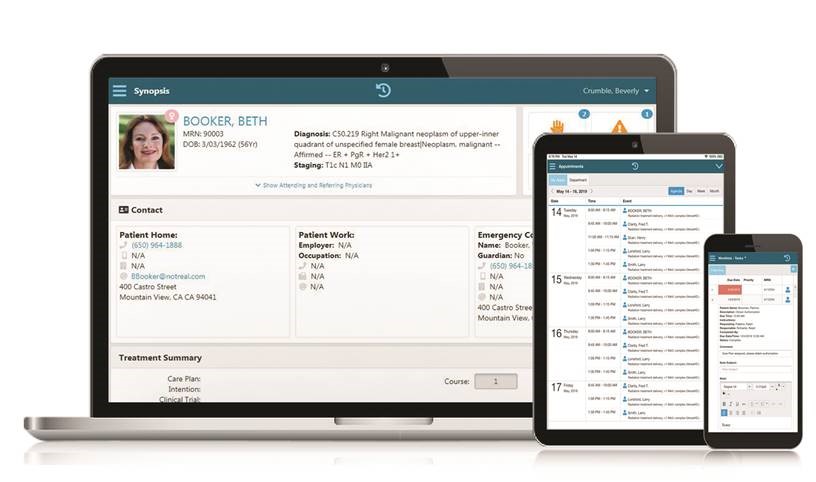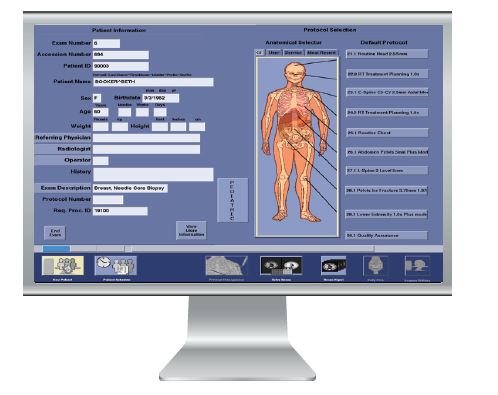Introduction
In radiation therapy, oncologists rely predominantly on medical imaging and patient information to develop a personalized treatment plan specific to the patient’s type of cancer, stage and prognosis. The oncology information system (OIS) is the key enabler of patient care – this core tool is at the heart of all important patient information store all in one place; from the patient’s previous electronic health record, images from diagnostic and simulation systems, treatment planning information and the recording of treatment from different types of treatment devices. The OIS utilizes this data to support treatment decisions and then translates these decisions into patient care coordination by organizing clinical staff activities, functioning both as a workflow management and clinical operations/scheduling system.
As part of the comprehensive and personalized treatment paradigm, CT simulation (CT Sim) also plays a key role in radiation therapy planning. Images and information are shared between the CT Sim and OIS using DICOM RT, the standard for the digital transfer of imaging data in radiation therapy. The CT Sim creates detailed images of the patient’s body that are used to develop a personalized treatment plan. Within imaging, a DICOM modality worklist is used to share patient information from the modality (e.g., CT Sim) to an information system (e.g., OIS, PACS, HIS). However, sharing information from the OIS to the CT Sim is not bi-directional and often requires manual data entry and (steps) that are prone to error and that can decrease clinical efficiency.
Further, often the treatment directive, or how the patient will be scanned in the CT Sim, is determined in the OIS by the radiation oncology team of oncologists, radiation therapists, medical physicists, and more. Information such as gating parameters, imaging protocols, patient positioning/immobilization and tumor region of interest (ROI) are used to help plan the CT Sim so that it accurately mimics how the patient will be treated. Additionally, oncologists or the oncology team will want to schedule the CT Sim within the OIS, requiring integration of the OIS with the CT Sim.
Considering that the OIS is the foundation of a personalized and intelligence-driven treatment process, the fact that it integrates/shares data from the OIS to the CT Sim enables an acceleration of the treatment process by increasing accuracy of patient information, sharing treatment directives and increasing clinical efficiency.
In an effort to help improve patient outcomes, GE Healthcare and Elekta are collaborating to improve integration of the OIS and CT Sim by integrating GE’s Discovery™ RT CT Sim with Elekta’s MOSAIQ OIS. Information such as the physician’s orders and patient data (e.g., name, ID, allergies/contraindications) can be shared from MOSAIQ to Discovery RT, including the DICOM Modality Worklist, to streamline clinical workflow, reduce errors and enable greater precision in treatment planning.
Here’s how it works.
Information from a new patient consultation is entered into the OIS by the clinical team, including tumor information (e.g., type), staging and treatment decisions. In cases where external beam radiation therapy is utilized, the patient will undergo CT Sim to localize the tumor/lesion and enable segmentation of both the tumor and the organs at risk for treatment planning. Details such as CT Sim imaging parameters and patient positioning/immobilization requirements are also included in the OIS patient profile. From MOSAIQ, the patient is then scheduled for simulation.
Next, from the Discovery RT user console, the user can load the daily patient schedule/worklist that resides within MOSAIQ. The radiation therapist can then select the appropriate patient from the worklist and import all patient-specific information from MOSAIQ into the Discovery RT, using the DICOM modality worklist, which contains all relevant patient data including name, ID, history, age and weight. Because this integration includes detailed patient data, information such as allergies to contrast media or existing liver disease, for example, it becomes available on the CT Sim console. The therapist can then select the appropriate protocol and begin scanning the patient.
The process optimizes the therapist’s workflow by enabling the auto-population of patient information from MOSAIQ to Discovery RT. It assures consistency and accuracy in patient data between the OIS and CT Sim by eliminating the need for manual data entry. Additionally, any clinical or simulation directive notes entered into the OIS are accessible at the CT Sim console.
Based on feedback from customers, the workflow for scheduling CT Sim with patient information from the OIS remains a manual process. These same customers expressed much interest for implementing the integrated workflow as described above.
The DICOM modality worklist is an vital factor of the integration because it supports the transfer of patient information from MOSAIQ to the Discovery RT, much as the DICOM modality worklist is used in radiology to pull important patient-specific information from the radiology information system (RIS), hospital information system (HIS) or electronic medical record (EMR) into an imaging modality.
GE Healthcare, Elekta partner to create an efficient, integrated workflow.
Together, GE and Elekta are innovating ways to improve radiation therapy patient outcomes, including utilizing the DICOM modality worklist in radiation oncology, allowing for the sharing of patient demographics, patient ID and treatment planning information across these two systems.
The integration of MOSAIQ and the Discovery RT is the first of several new integration projects planned between Elekta and GE to streamline imaging data and information from radiation oncology modalities and information systems to CT Sim and other imaging modality solutions, such as MR Sim and PET/CT. In addition to supporting precision in imaging for treatment purposes, the alliance between GE and Elekta includes exploring further program integrations, such as providing access to a radiation oncologist’s treatment directive. This could allow for simulation guidance to be passed directly from MOSAIQ to the GE simulation console, such as scanning parameters, ROI, immobilization devices, gating/motion management choices, and imaging modality.
Learn more about the collaboration of GE Heatlhcare and Elekta.
DISCLAIMER
Not all products or features are available in all geographies. Check with your local GE Healthcare representative for availability in your country.


